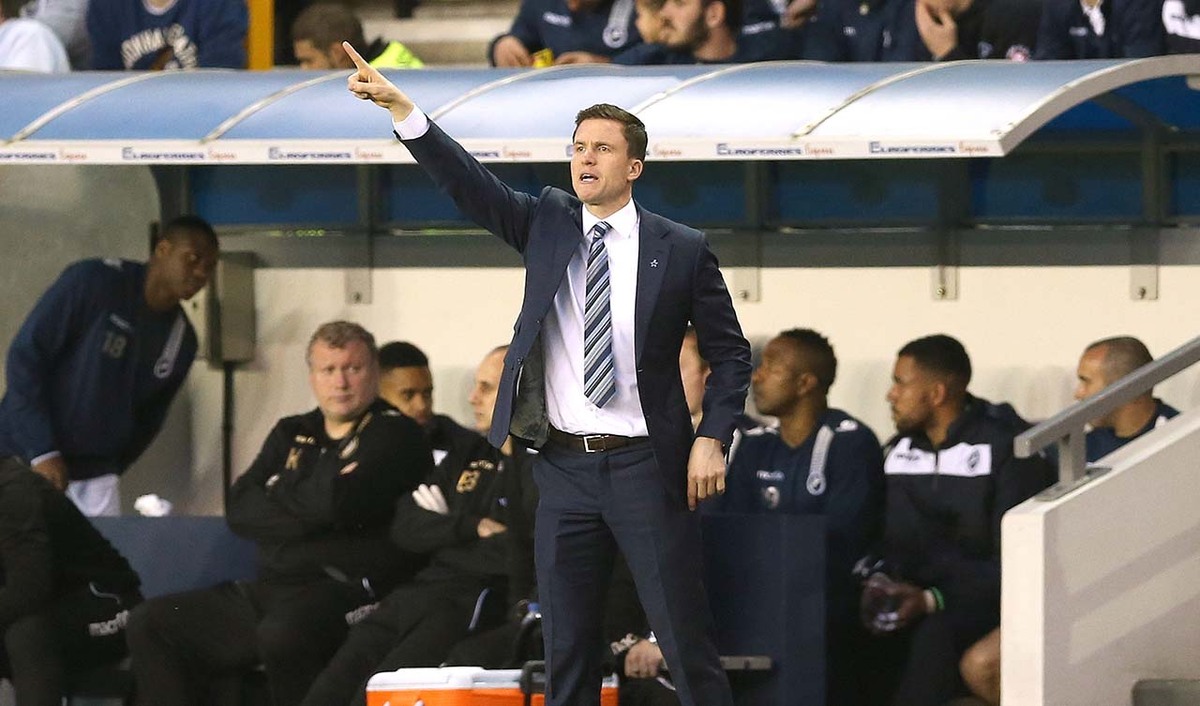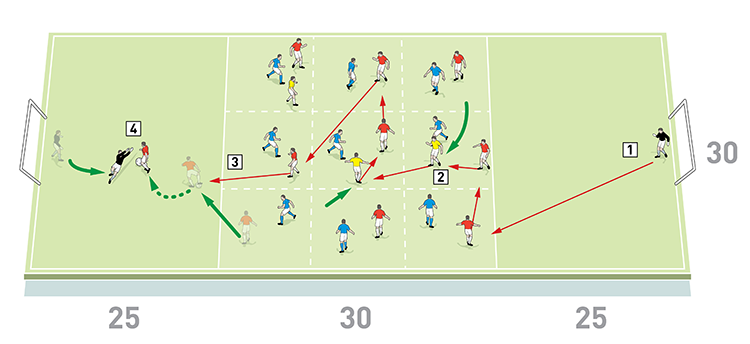Attacking with forward runs
Exploiting space and getting behind the opposition defence is a great way to create scoring opportunities. This session is designed to encourage players to make forward runs without the ball, in order to break the last line of defence.

| Area | Up to two thirds of pitch |
| Equipment | Ball, bibs, cones, 2 full size goals |
| No. of Players | Up to 21 players + 2 goalkeepers |
| Session Time | Each activity: 10-15mins |
Exploiting space and getting behind the opposition defence is a great way to create scoring opportunities. But, players need to recognise when these opportunities present themselves in a match. This session is designed to encourage players to make forward runs without the ball, in order to break the last line of defence.
The first activity can be run on any day of the training week and is a good possession game, with the emphasis on making forward runs without the ball in order to score. The second activity is great for the day before a game as the players don’t cover any distance but the coaching outcome is still achieved through the set up of the drill.
What do I get the players to do?
Line ball
We set up between the penalty boxes of the pitch with a 10-yard scoring zone at each end. This game can use any number of players but here we’re playing 9v9 plus 2 floaters, who give the attacking team an overload in possession, as shown [1].
One player starts by running into the end zone to collect a ball and his team must pass the ball until they create an opportunity to pass into the scoring zone at the end they are attacking. To score, a player has to run into the zone and receive the ball. Players can only enter the zone to run onto a pass and can’t stand waiting in the zone.
1

2. Teams must create the opportunity to pass into the scoring zone that they are attacking
3. To score, players must make runs to receive the ball in the end zone, but they cannot wait in the zone for a pass
4. Two floaters play for the team in possession, giving the attackers an overload
How do I progress the session?
To discourage the defending team from sitting back and just blocking rather than trying to gain the ball, we allow the possession team to score a point if they string 10 passes together.
We can progress the activity further by removing the neutral floaters and going man-to-man.
What do I get the players to do next?
1v1 grid game
We set up the playing area as shown [2], with a 25-yard end zone and a goal at each end. Between the end zones is a 30x30-yard square with nine 10x10-yard boxes marked out inside. We’re using 2 goalkeepers and 21 outfield players, who are divided into two teams of 9 and 3 floaters.
There’s a 1v1 set up in each of the nine boxes and players must stay in their boxes unless they are in the attacking front line, which is composed of the three boxes nearest to the goal that the team are attacking.
Play starts with a pass out from a goalkeeper to one of his defenders. Players have unlimited touches and must work the ball forwards by passing to their team mates and using the help of the three floaters, who can move anywhere and who play for the team in possession.
The aim is to get the ball to one of the forwards on the front line, who can pass into the scoring zone for a team mate to run onto, breaking the last line to go 1v1 against the goalkeeper and score in the goal. No other attackers or defenders may follow the runner into the scoring zone.
If a goal is scored or if the ball goes dead, play is restarted in the square with an attack going the other way.
2

2. Teams should work the ball forward with the help of the yellow floaters. Only floaters can move between boxes
3. When a player in the front line receives the ball, he can play a pass into the scoring zone for a team mate to run onto
4. One runner can break out to receive the pass and go 1v1 with the keeper. No other players may follow
How do I progress the session?
We can progress by allowing a recovering defender to also break out of the area when attackers go 1v1 against the goalkeeper.
Also, we make sure to rotate players regularly, so everyone has a turn in one of the boxes on the frontline and the chance to go 1v1 against the goalie. Maintain the locked-in 1v1 in each square after rotating players.
What are the key things to look out for?
We are looking for teams to create overloads in order to give players the time and space to make well-executed forward runs. We want players to demonstrate a willingness to make these runs and an understanding of when, and when not, to make them, as timing is key and players should be discouraged from forcing their passes.
Effective communication between the passer and the runner is also vital to the success of the session.
We want to see players using the correct weight and style of pass into space and the right body shape from the receiving player.
Editor's Picks
Attacking transitions
Deep runs in the final third
Using the goalkeeper in build-up play
Intensive boxes drill with goals
Penetrating the final third
Creating and finishing
My philosophy
Pressing initiation
Compact team movement
Coaches' Testimonials

Alan Pardew

Arsène Wenger

Brendan Rodgers

Carlos Carvalhal

José Mourinho

Jürgen Klopp

Pep Guardiola

Roy Hodgson

Sir Alex Ferguson

Steven Gerrard
Coaches' Testimonials

Gerald Kearney, Downtown Las Vegas Soccer Club

Paul Butler, Florida, USA

Rick Shields, Springboro, USA

Tony Green, Pierrefonds Titans, Quebec, Canada
Join the world's leading coaches and managers and discover for yourself one of the best kept secrets in coaching. No other training tool on the planet is written or read by the calibre of names you’ll find in Elite Soccer.
In a recent survey 92% of subscribers said Elite Soccer makes them more confident, 89% said it makes them a more effective coach and 91% said it makes them more inspired.
Get Monthly Inspiration
All the latest techniques and approaches
Since 2010 Elite Soccer has given subscribers exclusive insight into the training ground practices of the world’s best coaches. Published in partnership with the League Managers Association we have unparalleled access to the leading lights in the English leagues, as well as a host of international managers.
Elite Soccer exclusively features sessions written by the coaches themselves. There are no observed sessions and no sessions “in the style of”, just first-hand advice delivered direct to you from the coach.









